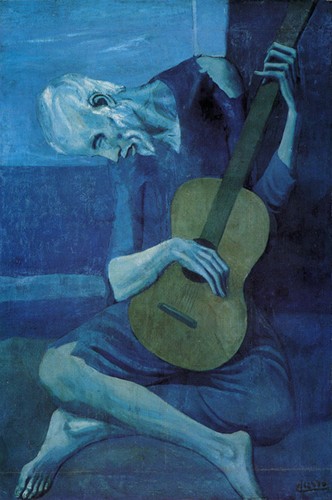
There's nothing quite like the Old Masters, is there? The sublime domesticity of the Arnolfinis, for instance, or Lippi's glorious Annunciation (above), its two figures - man and woman, angel and mortal - balanced so perfectly that the very burden of the news they share is rendered weightless, the fulcrum of God's hand proves irrelevant, and these two people, conspirators in the divine, seem bathed in the sheer resplendence of the moment: the shimmer of wings on his side, the glow of the chair-draping mantle on hers.
 But there are other, less anticipated delights to be found in this section of the National Gallery. Delights such as the paintings of Cosimo Tura, with their lifelike faces so at odds with the rest that I am reminded, for some strange reason, of Klimt; or the striking, almost X-ray like visions of Andrea Mantegna (such as Samson and Delilah - above - which looks at though it had been painted out of ash and magma) which seem to invert the light even as they blaze with it; or Sassetta's curiously feminine depiction of St. Francis as a chastely naked young man being embraced by the Church as his father rages at being renounced; or Cosimo's frenzied, writhing battle scene between the Centaurs and the Lapiths, with its Bosch-like landscape and its contrast between a huddle of panicked forms and the poignant image of a young woman mourning her dead lover, all enclosed in parantheses of violence. Not to mention Durer's startlingly lifelike portrait of his father (below) or his almost abstract expressionist depiction of the Last Judgement on the reverse side of a painting of Saint Jerome.
But there are other, less anticipated delights to be found in this section of the National Gallery. Delights such as the paintings of Cosimo Tura, with their lifelike faces so at odds with the rest that I am reminded, for some strange reason, of Klimt; or the striking, almost X-ray like visions of Andrea Mantegna (such as Samson and Delilah - above - which looks at though it had been painted out of ash and magma) which seem to invert the light even as they blaze with it; or Sassetta's curiously feminine depiction of St. Francis as a chastely naked young man being embraced by the Church as his father rages at being renounced; or Cosimo's frenzied, writhing battle scene between the Centaurs and the Lapiths, with its Bosch-like landscape and its contrast between a huddle of panicked forms and the poignant image of a young woman mourning her dead lover, all enclosed in parantheses of violence. Not to mention Durer's startlingly lifelike portrait of his father (below) or his almost abstract expressionist depiction of the Last Judgement on the reverse side of a painting of Saint Jerome.
But the real star of this section of the Gallery, for me, was indisputably Sandro Botticelli. The charming and forthright portrait of a delectable young man in a red beretta staring straight out at the viewer. The dramatic Venus and Mars, where the seriousness of the grown-ups - his exhaustion, her patient watchfulness - is set against the gaiety of the young satyrs (their casual games with the dread instruments of war both a triumph of innocence and a perversion), so that this meeting of two deities is transformed into a strangely domestic scene: the young husband returned from war wanting only to rest and forget, the wife a little awkward, watching him with a mix of anxiety and expectation, so completely absorbed in his presence that she barely notices the children running riot. And the glorious Adoration of the Kings (below), its circular shape drawing the eye inexorably to the Virgin and Child who are in every way the center of the scene, yet the painting itself almost triangular, a pyramid of forms rising in strict heirarchy from the mingled crowd of men and horses at the base, to the select circle of kings paying their homage to the infant Christ and further to the pointed wooden roof that hovers above the scene like a protective spirit, the plain wooden structure itself enclosed in an arch of the ruined temple (again the triangle enclosed within the semi-circle) that symbolizes the end of all things Roman even as it lends the scene a greater majesty, and is transformed, by the imagination, into a covenant of purity, an emblem of new entrances, and the ceiling of an impromptu stage. But most of all that unforgettable peacock, dainty as a courtier, regally surveying the scene, while behind and beneath him the horses neigh and the trumpets blare, proclaiming the arrival of the greatest King of all.





No comments:
Post a Comment